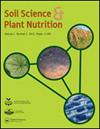The effects of simulated acid rain and cadmium-containing atmospheric fine particulate matter on the pakchoi (Brassica campestris. L) seedlings growth and physiology
IF 1.8
4区 农林科学
Q3 ENVIRONMENTAL SCIENCES
引用次数: 3
Abstract
ABSTRACT Acid rain (AR) and atmospheric particulate matter (APM) are important environmental issues that often occur simultaneously in agricultural regions, the combined pollution of AR and atmospheric fine particles (PM2.5) containing heavy metals has negatively affected the growth of seedlings and has become a hot research topic. In this paper, we established exposure scenarios to simulate the AR and the cadmium-containing PM2.5 (PM2.5-Cd) pollutions. Under the scenarios, hazardous impacts of AR and PM2.5-Cd on growth, physiological and biochemical characteristics of pakchoi were evaluated. After being exposed simulated AR and PM2.5-Cd for 21 days, our results indicate that: single treatment with either AR (pH 5.5) or PM2.5-Cd, or a combined treatment of AR (pH 5.5) and PM2.5-Cd (150, 300 μg·m−3) increased the growth of pack hoi seedlings. Combined treatments with low-acidity AR (pH 3.5) and PM2.5-Cd (500 μg·m−3), significantly decreased the growth and the Soil and Plant Analyzer Development (SPAD) of pakchoi, and it also induced a significantly increase in foliar MDA content and catalase (CAT) activity, while decreasing peroxidase (POD) and superoxide dismutase (SOD) activity. The Cd concentration of leaves increased with an increasing PM2.5-Cd concentration. Correlation analysis indicated that the growth and SPAD of pakchoi were highly correlated with the foliar MDA content and enzyme activities under the combined treatments with AR and PM2.5-Cd treatment. Our results might serve as a guide to increase agricultural production and food crop safety in areas with high levels of AR and PM2.5 pollution.模拟酸雨和含镉大气细颗粒物对小白菜生长的影响。L)幼苗生长和生理
摘要酸雨(AR)和大气颗粒物(APM)是农区经常同时发生的重要环境问题,其与含重金属的大气细颗粒物(PM2.5)的复合污染对苗期生长产生了负面影响,已成为研究热点。在本文中,我们建立了暴露情景来模拟AR和含镉的PM2.5 (PM2.5- cd)污染。在此情景下,评价了AR和PM2.5-Cd对小白菜生长和生理生化特性的有害影响。结果表明:AR (pH 5.5)或PM2.5-Cd单独处理,AR (pH 5.5)和PM2.5-Cd(150、300 μg·m−3)联合处理均能促进海苔幼苗的生长。低酸性AR (pH 3.5)和PM2.5-Cd (500 μg·m−3)联合处理显著降低了小白菜生长和土壤与植物分析仪发育(SPAD),显著提高了叶片丙二醛(MDA)含量和过氧化氢酶(CAT)活性,降低了过氧化物酶(POD)和超氧化物歧化酶(SOD)活性。叶片Cd浓度随PM2.5-Cd浓度的增加而增加。相关分析表明,AR和PM2.5-Cd联合处理下小白菜的生长和SPAD与叶片MDA含量和酶活性高度相关。我们的研究结果可能为AR和PM2.5高污染地区提高农业生产和粮食作物安全提供指导。
本文章由计算机程序翻译,如有差异,请以英文原文为准。
求助全文
约1分钟内获得全文
求助全文
来源期刊

Soil Science and Plant Nutrition
农林科学-农艺学
CiteScore
4.80
自引率
15.00%
发文量
56
审稿时长
18-36 weeks
期刊介绍:
Soil Science and Plant Nutrition is the official English journal of the Japanese Society of Soil Science and Plant Nutrition (JSSSPN), and publishes original research and reviews in soil physics, chemistry and mineralogy; soil biology; plant nutrition; soil genesis, classification and survey; soil fertility; fertilizers and soil amendments; environment; socio cultural soil science. The Journal publishes full length papers, short papers, and reviews.
 求助内容:
求助内容: 应助结果提醒方式:
应助结果提醒方式:


